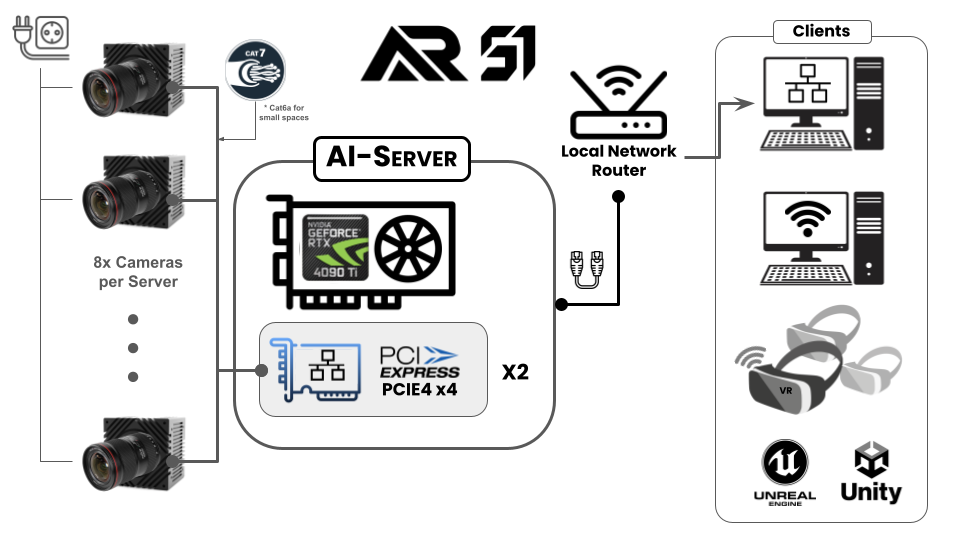AR-51 Mocap System Architecture Overview
Table of contents
System Overview

High-Resolution Cameras
The system utilizes an array of cameras, available in both 9MP and 5MP models, each capable of recording at a high-speed rate of 120 frames per second. This setup ensures the capture of smooth and precise motion data, which is crucial for the fidelity of the end-use application, whether it be for immersive VR experiences, realistic character animations in games, or accurate motion analysis in sports science. Since the data that is gathered by the cameras is massive, each camera needs to be connected by a fast ethernet connection directly to the AI server.
Ensure that the cameras are directly linked to the server, as most routers or switches may not be capable of managing the substantial network traffic from the cameras to the server. Additionally, it is important to use high-quality connecting cables (Cat7 or Cat6a for shorter distances).
The AI-Server
The AI-Server, the processing nucleus of the system, is outfitted with an high-end NVIDIA graphics card. To support the high bandwidth requirements of multiple camera inputs, the server includes two PCI Express PCIe4 x4 ethernet extension cards, each providing four 10Gbps ports, totaling eight ports to accommodate the connectivity for all cameras.
Ensure that the AI-Server meets the requirements by reviewing the minimum specifications detailed on the provided page.
Ultra-Low Latency - an On-Prem Solution
With the high-speed capture and processing capabilities, the system achieves an ultra-low latency of 9ms. This rapid response time is pivotal for real-time applications, ensuring that VR users and VFX artists can interact with and capture motion data seamlessly.
Mocap Studio
Complementing the hardware is Mocap Studio, AR-51’s proprietary desktop application that acts as a client for visualizing, editing, and exporting motion capture data into various industry-standard animation file formats, including FBX. Mocap Studio is an invaluable resource for VFX artists, animators, and researchers, providing an extensive suite of tools for detailed motion editing and data management.
Cross-Platform Clients - Unity or Unreal
The system’s versatility extends to its client-side applications, supporting desktop VR systems, standalone VR headsets, laptops, and workstations. The AR-51’s plug-and-play plugins for Unity and Unreal engines facilitate effortless integration, automatically detecting the server to minimize setup time for developers and artists. These capabilities make it an ideal tool for creating interactive VR experiences, animating 3D characters, or visualizing motion for analytical purposes.
Mocap Unleashed Network
A Local Network Solution
The Mocap Unleashed solution operates within a local network framework. This necessitates that all components are linked to the same network subnet. Once connected to this network segment, each component signals its presence to the network, allowing the system to automatically recognize all connected components.
All components of the system must be linked to the same local network for proper operation. Failure to connect them to the same network will result in an inability for the components to recognize each other.
Ensuring a High-Performance Network
To maintain the system’s integrity and its capacity for real-time operations, it is critical that all network connections are sufficiently robust to handle the data throughput demands of 10 Gigabit cameras. These cameras are directly connected to the server through a PCIe network card. It is also important to use high-quality network cables, specifically cat7 cables, or cat6a for shorter distances, to ensure optimal performance.
Using slow cables or those susceptible to interference can significantly impact the system’s performance negatively. If you decide to use CAT6a cables, ensure they are kept at a distance from power cables to avoid electrical interference, as CAT6a are unshielded and more susceptible.
Disabling Deep-Packet Inspection
Certain antivirus software, such as Trend-Micro, may implement deep packet inspection on all incoming and outgoing data, significantly impairing the system’s performance and data throughput. To avoid substantial performance degradation, it is advised to either disable these deep packet inspection programs or configure exceptions within them.
Unless removed, deep packet inspection program can cause serious performance issues.